April 9, 2013
Books For Sale!
 On Saturday morning, Harriet’s playschool (Huron Playschool Cooperative) will hold their annual Book/Toy/Bake Sale to raise funds for the Jenna Morrison Family Trust. This event nicely coincides with my need to rid my house of much of its contents, and so I will be donating a huge pile of adult books to the sale, and some of them are really good.
On Saturday morning, Harriet’s playschool (Huron Playschool Cooperative) will hold their annual Book/Toy/Bake Sale to raise funds for the Jenna Morrison Family Trust. This event nicely coincides with my need to rid my house of much of its contents, and so I will be donating a huge pile of adult books to the sale, and some of them are really good.
Good books at good prices for a good cause–what could be better? Come out on Saturday April 13 from 10:00-12:30, 383 Huron St.
April 7, 2013
New kids' books we've been enjoying lately
 Mister Dash and the Cupcake Calamity by Monica Kulling and Esperanca Melo: Before reading this book, we’d thought about its title and speculated as to what the calamity might be, and we were wrong wrong wrong. We hadn’t yet read the first Mister Dash book, so we had no idea that Mister Dash himself would be the picture of calmness and civility while the calamity was everything that happened around him. When Madame Croissant decides to start up a cupcake company, she enlists her faithful hound to help (and makes him wear a baker’s hat, much to his dismay). When the tornado that is Madame Croissant’s granddaughter Daphne enters the mix, there has to be cupcake batter scraped off the ceiling and other calamities averted. In every situation, Mister Dash narrowly saves the day, and all are overjoyed in the end to find the cupcake business is a go-go! Especially since Mister Dash is finally allowed to take his silly hat off.
Mister Dash and the Cupcake Calamity by Monica Kulling and Esperanca Melo: Before reading this book, we’d thought about its title and speculated as to what the calamity might be, and we were wrong wrong wrong. We hadn’t yet read the first Mister Dash book, so we had no idea that Mister Dash himself would be the picture of calmness and civility while the calamity was everything that happened around him. When Madame Croissant decides to start up a cupcake company, she enlists her faithful hound to help (and makes him wear a baker’s hat, much to his dismay). When the tornado that is Madame Croissant’s granddaughter Daphne enters the mix, there has to be cupcake batter scraped off the ceiling and other calamities averted. In every situation, Mister Dash narrowly saves the day, and all are overjoyed in the end to find the cupcake business is a go-go! Especially since Mister Dash is finally allowed to take his silly hat off.
 Oy. Feh. So? by Cary Fagan and Gary Clement: I don’t think I’m the target audience for this book, as no one in my family has ever used a lot of Yiddish, but I do know about great aunts and uncles, the kind who would visit on Sundays in enormous automobiles. These relatives at a remove who plant themselves on the couch and aren’t so interested in the children. In Oy. Feh. So?, Aunt Essy, Aunt Chanah and Uncle Sam aren’t interested in anything, all attempts at conversation resulting in their respective signature exclamations, and so one Sunday the kids decide they aren’t going to take it and go to extremes to rattle their unshakably miserable rellies. It’s a funny story that appeals to a similar nostalgia as Barbara Reid’s The Party, the humour underlined by Clement’s cartoon illustrations.
Oy. Feh. So? by Cary Fagan and Gary Clement: I don’t think I’m the target audience for this book, as no one in my family has ever used a lot of Yiddish, but I do know about great aunts and uncles, the kind who would visit on Sundays in enormous automobiles. These relatives at a remove who plant themselves on the couch and aren’t so interested in the children. In Oy. Feh. So?, Aunt Essy, Aunt Chanah and Uncle Sam aren’t interested in anything, all attempts at conversation resulting in their respective signature exclamations, and so one Sunday the kids decide they aren’t going to take it and go to extremes to rattle their unshakably miserable rellies. It’s a funny story that appeals to a similar nostalgia as Barbara Reid’s The Party, the humour underlined by Clement’s cartoon illustrations.
 Hoogie in the Middle by Stephanie McLellan and Dean Griffiths: This was one book that did not immediately appeal to my adult kid-lit-loving sensibilities, but I knew something was up when Harriet suddenly couldn’t stop talking about it. (“You be Pumpkin, you be Tweezle, and I’ll be Hoogie,” she’d demand of whoever was in her company, or a variation on this.) I asked her why she liked the book so much: “Because Hoogie’s a monster and she’s nice,” Harriet answered, and I liked that answer. In her family of Muppet-like creatures, Hoogie is not the biggest or the smallest, but she’s stuck in the middle instead–ever too big or too little. Until one day her frustration gets too much and Hoogie explodes, and then her parents take the time and let her know how much they love their monster in the middle (“You’re the sun in the middle of the solar system,” says Dad, as they swing her through the air. “The pearl in the middle of the oyster,” says Mom as they catch her in their arms.”) This is a good teaching book for any middle child, but also (I have a feeling!) useful for any little one suffering a bit of family displacement. Hoogie will help them to articulate their feelings and know they aren’t alone.
Hoogie in the Middle by Stephanie McLellan and Dean Griffiths: This was one book that did not immediately appeal to my adult kid-lit-loving sensibilities, but I knew something was up when Harriet suddenly couldn’t stop talking about it. (“You be Pumpkin, you be Tweezle, and I’ll be Hoogie,” she’d demand of whoever was in her company, or a variation on this.) I asked her why she liked the book so much: “Because Hoogie’s a monster and she’s nice,” Harriet answered, and I liked that answer. In her family of Muppet-like creatures, Hoogie is not the biggest or the smallest, but she’s stuck in the middle instead–ever too big or too little. Until one day her frustration gets too much and Hoogie explodes, and then her parents take the time and let her know how much they love their monster in the middle (“You’re the sun in the middle of the solar system,” says Dad, as they swing her through the air. “The pearl in the middle of the oyster,” says Mom as they catch her in their arms.”) This is a good teaching book for any middle child, but also (I have a feeling!) useful for any little one suffering a bit of family displacement. Hoogie will help them to articulate their feelings and know they aren’t alone.
 What a Party! by Ana Maria Machado and Helene Moreau: This is a bit like those If You Give a Mouse a Cookie books, but so much more interesting, and involving birthday parties, which is a pretty important topic if you happen to be four years old. The book posits what might happen if your mom, in a moment of distraction, tells you to invite “anyone you’d like” to your upcoming party, and then you invite everyone you know, who happens to also resemble the United Nations, and each friend brings a party food from their own particular culture and pets (which are another topic of fascination if you’re four). The party becomes a glorious celebration of delicious food, live music, salsa dancers and a raggae band, and then it goes all night long (which could happen “especially if the parents drop in and start having drinks and chatting instead of going home”). What a Party! is the perfect recipe for the “craziest, wildest, funnest party ever”, Moreau’s illustrations capturing the festive mood perfectly.
What a Party! by Ana Maria Machado and Helene Moreau: This is a bit like those If You Give a Mouse a Cookie books, but so much more interesting, and involving birthday parties, which is a pretty important topic if you happen to be four years old. The book posits what might happen if your mom, in a moment of distraction, tells you to invite “anyone you’d like” to your upcoming party, and then you invite everyone you know, who happens to also resemble the United Nations, and each friend brings a party food from their own particular culture and pets (which are another topic of fascination if you’re four). The party becomes a glorious celebration of delicious food, live music, salsa dancers and a raggae band, and then it goes all night long (which could happen “especially if the parents drop in and start having drinks and chatting instead of going home”). What a Party! is the perfect recipe for the “craziest, wildest, funnest party ever”, Moreau’s illustrations capturing the festive mood perfectly.
April 3, 2013
The Sally Draper Poems
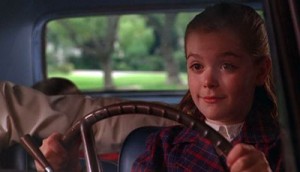 While I never finished reading The Collected Stories of John Cheever, which has been sitting on the table before me now for more than 2 years, my literary obsession with Mad Men continues, as does my obsession with Mad Men in general. (We have spent the last while rewatching the entire series, and are now partway through Season 4. We will save Season 6 until our baby sleeps for at least an hour at a time. Basically, I do not care to acknowledge that there are any other televisions shows in the world.)
While I never finished reading The Collected Stories of John Cheever, which has been sitting on the table before me now for more than 2 years, my literary obsession with Mad Men continues, as does my obsession with Mad Men in general. (We have spent the last while rewatching the entire series, and are now partway through Season 4. We will save Season 6 until our baby sleeps for at least an hour at a time. Basically, I do not care to acknowledge that there are any other televisions shows in the world.)
So I was overjoyed to read “The Sally Draper Poems”, written by one of my favourite poets Jennica Harper. These poems are so very good, demonstrating Harper’s sharp wit, gift for voice, and her amazing sympathy with a young girl’s perspective. I love the texture that they add to the Mad Men universe.
See also:
- My post, What Sally Draper Must Have Been Reading
- The poem “Don Draper” by Nyla Matuk, who has just been nominated for the Gerald Lampert Memorial Award
April 2, 2013
Bone and Bread by Saleema Nawaz
 In a way, it seems fitting to talk about a recipe in reference to Saleema Nawaz’s first novel Bone and Bread, a book that is so very much about food and hunger. It seems fitting to say that this is a novel absolutely packed/plotted with ingredients: family drama, tragedy, humour, intrigue, politics. Truly, there is something here to appeal to every reader (spectacular writing not the least of it), but really this wouldn’t be the right way to talk about the book at all, to reduce it to its parts. Because the thing about Bone and Bread is its very wholeness, the effortlessness nature of its construction. “It’s so good, and it’s not even trying,” was what I said to someone when I heard Saleema Nawaz read at Type Books two weeks back. I’d started reading it the evening before, burning through 100 pages before I turned my light out.
In a way, it seems fitting to talk about a recipe in reference to Saleema Nawaz’s first novel Bone and Bread, a book that is so very much about food and hunger. It seems fitting to say that this is a novel absolutely packed/plotted with ingredients: family drama, tragedy, humour, intrigue, politics. Truly, there is something here to appeal to every reader (spectacular writing not the least of it), but really this wouldn’t be the right way to talk about the book at all, to reduce it to its parts. Because the thing about Bone and Bread is its very wholeness, the effortlessness nature of its construction. “It’s so good, and it’s not even trying,” was what I said to someone when I heard Saleema Nawaz read at Type Books two weeks back. I’d started reading it the evening before, burning through 100 pages before I turned my light out.
I probably shouldn’t have been so blown away by the novel’s goodness though. That night at Type Books was the first time I met Saleema Nawaz in person, but I’ve known her online for a while, and I’ve known her best through her writing, through the essay she’s contributed to my forthcoming anthology. And from her essay, I knew already that Nawaz is the real thing, a writer as devoted to language as she is to story. The kind of writer who crafts lines like, “The truth was that I liked all [the bagel boys]. I wanted all of them in the way that a dissonant chord wants resolution, setting a vibration out into the world. In the way that a teenager wants to get her life started.”
“My sister and I stopped bleeding at the same time,” an early chapter begins. Told from the perspective of Beena who has always been strangely bound to her sister Sadhana, mainly through the eccentric nature of their upbringing, this line is emblematic of the ways in which the sisters’ experience are linked but ever worlds apart. Because Beena has stopped her period because she is pregnant, just sixteen years old after not even a real romance with one of the boys who works in her uncle’s bagel shop. While Sadhana’s anorexia has begun to overtake her body and mind, a disease whose symptoms would come and go, but would eventually claim her life 18 years later.
Perhaps it’s just because I am pregnant myself, but I don’t know how I could have made it through this book without the wood fire bagel place that has recently opened in close range of my house. Nawaz writes so evocatively about food and hunger, the novel’s most central metaphors, but she renders them literally as well, so much so that it made my stomach growl. Beena and Sadhana are raised in the apartment above the bagel shop in Montreal, the shop that had been their father’s until his sudden death. They’d lived in the apartment with their mother until her death (at the dinner table, yes) during their early teen years, after which their severe and distant uncle became reluctantly enlisted with their care. It’s soon after this that they both stop bleeding, each girl’s life taking on a remarkably separate trajectory even as their experiences remain inextricably linked.
These events are narrated by Beena in the present day who is still in shock from her sister’s death six months before, and who suffers its fall-out as her eighteen year-old son Quinn clearly blames her for what happened to his beloved aunt. But what did happen to Sadhana? Beena is not entirely sure. She suspects her son knows more about it than he’s letting on, and that there is a connection between Sadhana and the probing questions Quinn has started asking about the father he never knew. The web becomes more complicated as Beena uncovers a link between Sadhana’s political work advocating for a refugee and Quinn’s father who has become a right-wing anti-immigrant politican in Quebec and whose name is turning up everywhere. Beena must face her own questions about the cirumstances of her sister’s death and the possibility of her own complicity in its circumstances.
This is a fascinating novel about sisterhood, and what is most compelling about it, in spite what this novel’s gorgeous cover design might suggest, is that there is no symmetry between Beena and Sadhana. They’re not twins, though there is something twin-like in the bond between them, but this is mainly in that, as the text points out at one point, it’s difficult to tell where one sister ends and the other begins. They are complicated, messy personalities who are compatible in some respects, but drive each other apart in others. Their love is as intense as their rivalry and the conflict ever firing between them. Sadhana’s true nature is obscured by Beena’s perspective, as there was so much she never knew about her sister, and so she remains an enigma haunting the novel. But Beena too is just as hard to read, and in many ways she’s as unknown to herself as she is to her reader, and unpuzzling both these women who refuse to be pinned down (or earn our outright sympathy) is one of the book’s most fascinating pleasures.
Bone and Bread is an intense read, 400 pages but a fast read, gorgeously literary and a page-turner. And I’m not really sure what possible recipe could ever come up with such a mix, but as a reader I am overjoyed that Saleema Nawaz worked it out so well.
April 1, 2013
The Love Song of Laura Ingalls Wilder by Sharon McCartney
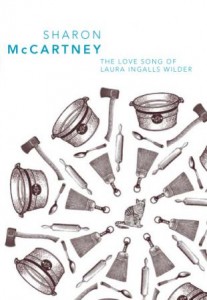 Marita Dachsel recommended The Love Song of Laura Ingalls Wilder by Sharon McCartney right when our family was in the middle of reading On the Banks of Plum Creek, and so it seemed like an irresistible pick. Because we’ve been so fascinated by the gaps and silences in the Little House books, by what goes on between the lines. What is it to be Caroline Ingalls, we’ve been wondering for a while, and are there varying tones to her declarations of, “Oh, Charles.”? What does “Oh, Charles.” really mean?
Marita Dachsel recommended The Love Song of Laura Ingalls Wilder by Sharon McCartney right when our family was in the middle of reading On the Banks of Plum Creek, and so it seemed like an irresistible pick. Because we’ve been so fascinated by the gaps and silences in the Little House books, by what goes on between the lines. What is it to be Caroline Ingalls, we’ve been wondering for a while, and are there varying tones to her declarations of, “Oh, Charles.”? What does “Oh, Charles.” really mean?
In her foreward, Sharon McCartney writes of her poems, “I don’t think of them as being an extension of Wilder’s stories. Rather, the voices, the characters, and the details are vehicles, a way to say what I want to say.” But saying what she wants to say via these characters, voices, details renders these poems familiar territory for me, which is important when poetry itself is decidedly not.
From “Ma”: “This morning I addressed the roof beams, /Charles twitching in sleep beside me: /Today I will do whatever I want.” I was amazed by the perspective of a bull-dog in, “Jack, Swept Away When the River Rises Suddenly Mid-Ford” and of the tattered rag-doll in “Charlotte”. Some poems I suppose I read as voyeuristic glimpses deeper inside the book, such as “Nellie Olesen” which imagines Laura’s nemesis years later, sitting mildly at a temperance meeting. “Pa’s Penis” was not as naughty as we’d imagined.
The Love Song of Laura Ingalls Wilder has much in common with Lorna Crozier’s recent collection The Book of Marvels, itself a catalogue of the hidden lives of ordinary things. As interesting as “Pa’s Penis” and the revelation that the Ingalls family had a son who died at nine months of age is the poem from the perspective of the butter churn, the chinook, a rocking chair, the boughten broom. As interesting as the Little House allusions are the poems themselves, and how they turn familiar territory into a vision that’s altogether new.
April 1, 2013
On being that innocent again.
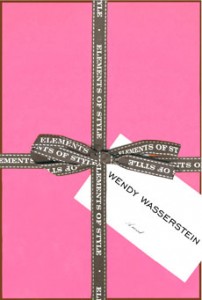 I took myself out for lunch on Saturday, with Wendy Wasserstein’s The Elements of Style for company. I haven’t eaten alone in a restaurant for a long time (and in fact, I rarely get to eat in restaurants without the company of someone who is ever in danger of knocking over her water glass and ever requires ketchup and grubby crayons as a garnish), but learning the pleasures of doing so was once upon a time one of the greatest lessons in my education of being a grown-up woman. So when the prospect of a free Saturday afternoon presented itself to me, a solo lunch date was at the top of my agenda. A brand new baby is scheduled to explode into my life in about 8 weeks, and who knows when I’ll ever get to be alone again?
I took myself out for lunch on Saturday, with Wendy Wasserstein’s The Elements of Style for company. I haven’t eaten alone in a restaurant for a long time (and in fact, I rarely get to eat in restaurants without the company of someone who is ever in danger of knocking over her water glass and ever requires ketchup and grubby crayons as a garnish), but learning the pleasures of doing so was once upon a time one of the greatest lessons in my education of being a grown-up woman. So when the prospect of a free Saturday afternoon presented itself to me, a solo lunch date was at the top of my agenda. A brand new baby is scheduled to explode into my life in about 8 weeks, and who knows when I’ll ever get to be alone again?
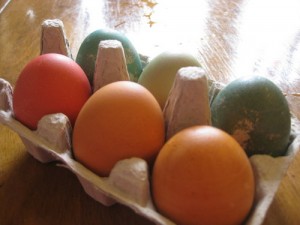 I did enjoy this blog post by a writer who is about to give birth to her second child and contemplating the distance she’s travelled since she was waiting to birth her first. She writes about the loss of self that transpires when a woman becomes a mother, and looks forward to this new birth because it will occur without that loss. I feel similarly. Harriet made me a mother, which was a difficult, nearly traumatic, absolutely not natural for me experience. When she was born, I did not know how to love a child as a mother does, and I had to grow into that love. I tell her all the time how I did not know how to be a mother before her, and how she taught me, and how excited I am to meet her sibling because I know how to do it now. The love I have for our new baby already comes via my love for Harriet, as though Harriet is the connection between us. Harriet, of course, sees nothing unusual about being a linchpin. She is quite sure that she is the centre of the universe after all.
I did enjoy this blog post by a writer who is about to give birth to her second child and contemplating the distance she’s travelled since she was waiting to birth her first. She writes about the loss of self that transpires when a woman becomes a mother, and looks forward to this new birth because it will occur without that loss. I feel similarly. Harriet made me a mother, which was a difficult, nearly traumatic, absolutely not natural for me experience. When she was born, I did not know how to love a child as a mother does, and I had to grow into that love. I tell her all the time how I did not know how to be a mother before her, and how she taught me, and how excited I am to meet her sibling because I know how to do it now. The love I have for our new baby already comes via my love for Harriet, as though Harriet is the connection between us. Harriet, of course, sees nothing unusual about being a linchpin. She is quite sure that she is the centre of the universe after all.
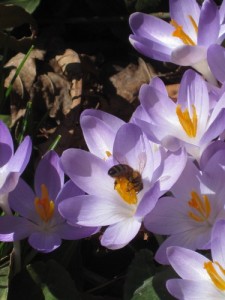 There is something different about going over the edge of a cliff when you’ve been over the cliff before. I spent my entire pregnancy with Harriet in a state of disbelief, really, not remotely convinced that there would be a baby at the end of it. There had never been a baby more unfathomable than Harriet, I supposed, so even my birth preparations were half-hearted, and I never allowed myself to imagine beyond it. This time, however, I’m going over the cliff and recognizing all the landmarks. I know even that the cliff itself is not the point, and that the journey beyond goes on and on. I have a concrete awareness of my own limits as well, which were pretty much the greatest lessons I took away from new motherhood, and I’m not going to deny them. This is why my husband will be spending the summer at home with us as we settle into life as a family of four. This is why we’ve bought a queen-sized bed. This is why I will unabashedly read through breastfeeding marathons instead of staring into my baby’s goopy eyes. This is why I’m going to hate having a baby sometimes and I’m not going to beat myself up about that. I will not enjoy every minute. This is why I’m not going to push myself to recreate ordinary life right away as the dust settles from our new baby’s arrival. This time, I know that ordinary life will come back without me even trying. That the trying is the hardest part, and I just have to be patient instead. I just have to get a little bit better at being patient.
There is something different about going over the edge of a cliff when you’ve been over the cliff before. I spent my entire pregnancy with Harriet in a state of disbelief, really, not remotely convinced that there would be a baby at the end of it. There had never been a baby more unfathomable than Harriet, I supposed, so even my birth preparations were half-hearted, and I never allowed myself to imagine beyond it. This time, however, I’m going over the cliff and recognizing all the landmarks. I know even that the cliff itself is not the point, and that the journey beyond goes on and on. I have a concrete awareness of my own limits as well, which were pretty much the greatest lessons I took away from new motherhood, and I’m not going to deny them. This is why my husband will be spending the summer at home with us as we settle into life as a family of four. This is why we’ve bought a queen-sized bed. This is why I will unabashedly read through breastfeeding marathons instead of staring into my baby’s goopy eyes. This is why I’m going to hate having a baby sometimes and I’m not going to beat myself up about that. I will not enjoy every minute. This is why I’m not going to push myself to recreate ordinary life right away as the dust settles from our new baby’s arrival. This time, I know that ordinary life will come back without me even trying. That the trying is the hardest part, and I just have to be patient instead. I just have to get a little bit better at being patient.
I also have to avoid the inclination to try to get it right this time. There really is no getting it right. This is not a do-over. New motherhood is a mad fumble, no matter what you do, and one way or another, I’m going to end up crying on the floor without clothes on. But I will not be surprised when it happens this time, and that is really something.
I never thought I could be this open-eyed excited about having another child. When Harriet was small, I looked back at the end of my pregnancy with the saddest nostalgia. “We’ll never be that innocent again,” I remember thinking after bringing our small baby over to visit friends whose own baby’s birth was imminent. But somehow, we’ve unlearned reality and I’m excited again. Maybe I’ve become wise enough to know we’ll get through the hard times, that they’re worth it. Or maybe I’m a fool and the return to innocence is just a survival mechanism.
A bit of both, perhaps. I guess we’ll have to see what I have to say about it all once I’m back there crying on the floor.
March 27, 2013
Oh, the poets.
 Oh, the poets. I know you half-hate readers like me. Hate by half only because I’m not totally terrible. I keep buying your books, and sometimes I even read them, but not always. I start to read and get distracted by bigger books, by books that don’t require so much attention. And when I do read and it comes time to talk about the books, I never know what to say (mostly because the gate-keepers of poetry conversation are seriously terrifying and I can never tell if they’re joking or not). And poets, I don’t always understand what you’re trying to say. And now I’m doing the very worst thing of all, which is examining my growing stack of poetry books and determining that April would be a fine time to read them. But in my defense, it’s not just because April is Poetry Month. I promise. It just so happens that most of these books have happened to come into my life at this point in time (I was summoned twice by Book City today by a call that a poetry book I’d 0rdered had come in), and I really need to get through my to-be-reads before the baby is born. So I will be reading poetry in April–forgive me please the cliche. The books before me look really fantastic though and I can’t wait to share them with you.
Oh, the poets. I know you half-hate readers like me. Hate by half only because I’m not totally terrible. I keep buying your books, and sometimes I even read them, but not always. I start to read and get distracted by bigger books, by books that don’t require so much attention. And when I do read and it comes time to talk about the books, I never know what to say (mostly because the gate-keepers of poetry conversation are seriously terrifying and I can never tell if they’re joking or not). And poets, I don’t always understand what you’re trying to say. And now I’m doing the very worst thing of all, which is examining my growing stack of poetry books and determining that April would be a fine time to read them. But in my defense, it’s not just because April is Poetry Month. I promise. It just so happens that most of these books have happened to come into my life at this point in time (I was summoned twice by Book City today by a call that a poetry book I’d 0rdered had come in), and I really need to get through my to-be-reads before the baby is born. So I will be reading poetry in April–forgive me please the cliche. The books before me look really fantastic though and I can’t wait to share them with you.
See also my list: Poetry Books I’ve Read This Year
March 27, 2013
The Stop by Nick Saul and Andrea Curtis
 Oh, there is nothing quite like the The Stop’s Farmers’ Market. To get there, we have to trudge up the hill above Davenport Road, which is no small feat pushing a stroller, but the journey is worth it. In the winter, to arrive inside the big hall at Wychwood Barns, full to bursting with people touring around the tables heaped with fresh produce, delicious breads and cheeses, and other wonderful things. In the summer, the market spills outside into the grounds surrounding the Barns, and you’ve got to set a budget or else you’ll go mad–cherries, pickles on sticks, cinnamon buns, sushi, honey, cookies. We don’t want to snack too much because we’re planning on having our lunch at the Market Cafe, and then after lunch, the kids play on the splash pad while we wait, hoping the artisanal cheese doesn’t melt in the bottom of the stroller. Such concerns such a luxury and these Saturday mornings a highlight of family life in the city.
Oh, there is nothing quite like the The Stop’s Farmers’ Market. To get there, we have to trudge up the hill above Davenport Road, which is no small feat pushing a stroller, but the journey is worth it. In the winter, to arrive inside the big hall at Wychwood Barns, full to bursting with people touring around the tables heaped with fresh produce, delicious breads and cheeses, and other wonderful things. In the summer, the market spills outside into the grounds surrounding the Barns, and you’ve got to set a budget or else you’ll go mad–cherries, pickles on sticks, cinnamon buns, sushi, honey, cookies. We don’t want to snack too much because we’re planning on having our lunch at the Market Cafe, and then after lunch, the kids play on the splash pad while we wait, hoping the artisanal cheese doesn’t melt in the bottom of the stroller. Such concerns such a luxury and these Saturday mornings a highlight of family life in the city.
That’s not the half of it though, as demonstrated by the stories told in the new book The Stop: How the Fight for Good Food Transformed a Community and Inspired a Movement by Nick Saul and Andrea Curtis. We thought we knew what The Stop was all about–I bought their cookbook a few years ago, and used it so thoroughly that it no longer has bindings (and I continue to use it still- oh, the fish tacos, the beef stew, that strawberry bread!!). We visit the market a few times a year when we’re hungry and in need of a trek. And this Christmas, we divided our annual food-bank donation in two and gave half the money to The Stop instead. But for all our enthusiasm, it turns out we didn’t know The Stop at all.
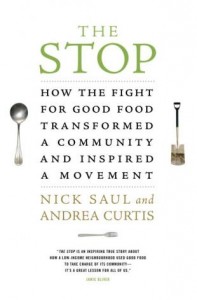 It turns out that the hub of The Stop is not the Green Barn, where the farmers’ market takes place each week, where Jamie Oliver paid a visit not too long ago. The real heart of The Stop, instead, lies a few kilometres west down Davenport Road at their main office, which was a small food bank when Nick Saul became executive director in 1998. It didn’t take long for Saul in this role to become disillusioned with the food bank system, which, he tells us, is a relatively recent invention. Food banks came about in the 1980s as a temporary solution to community hunger, but they stayed around as government programs for dealing with these problems were being reduced at the very same time. And now it seems as though we’ve always had them, food banks, systems we support by dumping store-brand Kraft Dinner in grocery store bins every once in a while before heading home to feast on artisanal cheese and organic kale.
It turns out that the hub of The Stop is not the Green Barn, where the farmers’ market takes place each week, where Jamie Oliver paid a visit not too long ago. The real heart of The Stop, instead, lies a few kilometres west down Davenport Road at their main office, which was a small food bank when Nick Saul became executive director in 1998. It didn’t take long for Saul in this role to become disillusioned with the food bank system, which, he tells us, is a relatively recent invention. Food banks came about in the 1980s as a temporary solution to community hunger, but they stayed around as government programs for dealing with these problems were being reduced at the very same time. And now it seems as though we’ve always had them, food banks, systems we support by dumping store-brand Kraft Dinner in grocery store bins every once in a while before heading home to feast on artisanal cheese and organic kale.
The Stop is written by Saul and his wife, award-winning writer Andrea Curtis, but told in Saul’s voice as he outlines his decade and a half with the organization. The problems with the food bank, he realized quickly, were manifold: it was a stop-gap measure; users picked up their hampers and left feeling diminished; the contents of the hampers weren’t anything that anyone would choose to eat, and did nothing to contribute to a healthy diet. There were other things going on at The Stop though that were having a more positive impact, such as their Healthy Beginnings Program, which taught food and nutrition skills to pregnant low-income women. Other initiatives came about–a community garden, cooking classes, drop-in meals. Around all these, a real sense of community began to form. Users came to The Stop and began to find it empowering, to find places where they could contribute to their communities and get involved.
Change is hard though, and Saul outlines how difficult it was to shift the centre’s focus away from the traditional food bank’s. First, because The Stop’s volunteers felt good about what they were doing and didn’t appreciate their efforts being criticized. The general consensus was that anyone using a foodbank hamper didn’t have the right to turn their nose up at anything, wilted lettuce, fetid peppers, and all. But Saul was convinced there had be a better way, and slowly, step-by-step, his organization began to blaze that trail. The community garden, he admits, is never going to feed the world, and there are many people who use The Stop whose problems are so complex that those problems are never going to be fully resolved, but many lives have been changed by the place (including those of the babies in their Healthy Beginnings program, all of whom were born at a healthy birth weight last year) and a community has found its spirit.
With The Stop’s Green Barn, Saul writes, “we can have a role tapping into the largely middle-class enthusiasm about food we’re seeing and connecting the dots between the poor and everyone else.” Because the poor, he explains, are largely excluded from the foodie revolution of the last few years. While I’m snacking on my organic kale chips, rising food costs are putting healthy food further and further out of reach of people who could benefit from it as much as I do. Saul checks Michael Pollan’s “vote with your fork” philosophy, and points out that for all the good of the movement, it leaves lower-income people as disenfranchised as they’ve ever been.
Nick Saul left The Stop in July 2012 to become president and CEO of Community Food Centres Canada, which aims to bring The Stop’s movement and innovations to communities across Canada, and after reading the book, I am confident in this new organization’s success and so excited by the work they’re doing. These aren’t political issues, Saul tells us, but instead these are issues of morality. The Stop is a fantastic story well told, compelling to read, and it will inspire readers to reconsider their relationships with both the food they eat and the people they live amidst.
March 26, 2013
Where does a month go when it's gone?
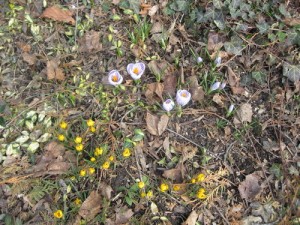 We were very happy to hear the word “benign” today when we visited the doctor for results of my biopsy. I have to see him again before my baby is born, and then once life settles down post-baby, decisions will be made about whether or not I’ll require surgery to take care of my lump for once and for all, but in the meantime, we’re relieved. It’s been just over a month since I found the lump, and what a crazy time it’s been. The last two weeks have thankfully been free of much worry, and to be honest, the news today was a bit of an anticlimax because it was what the doctor has set me up to expect. But I also find myself able to listen to There Must Be An Angel without bursting into tears for the first time in ages, so something essential must have shifted. (What is it with my propensity to listen to ad-nauseum to songs that make me cry? I imagine that this is something that men don’t do. Or women who aren’t ridiculous, for that matter.)
We were very happy to hear the word “benign” today when we visited the doctor for results of my biopsy. I have to see him again before my baby is born, and then once life settles down post-baby, decisions will be made about whether or not I’ll require surgery to take care of my lump for once and for all, but in the meantime, we’re relieved. It’s been just over a month since I found the lump, and what a crazy time it’s been. The last two weeks have thankfully been free of much worry, and to be honest, the news today was a bit of an anticlimax because it was what the doctor has set me up to expect. But I also find myself able to listen to There Must Be An Angel without bursting into tears for the first time in ages, so something essential must have shifted. (What is it with my propensity to listen to ad-nauseum to songs that make me cry? I imagine that this is something that men don’t do. Or women who aren’t ridiculous, for that matter.)
Today’s other piece of good news came today at the midwives where it was determined that Baby is (probably) head-down. I’m only 32 weeks so this could change at any time, but it’s significant for me because Harriet was transverse from 31 weeks and I’ve been paranoid that history might repeat itself, no matter that there was no physical reason that it would. I really don’t want to have another c-section, and we’ve become extremely keen about natural birthing (so yes, I’m back reading Ina May Gaskin again, after four years of making fun of her, and Harriet has been reading up on placentas and crowning). I am so fortunate to have many friends who have had successful home birth/natural birth experiences, and I’ve been steeping myself in their stories for inspiration and confidence in my own abilities to do similar things.
And it’s really not so far away. Terrifying. The last month has got away from us entirely, and now we must shift back to Baby, to all the things we have to do before Baby arrives. It’s a far more fun preoccupation than thyroid lumps, but overwhelming all the same.
March 25, 2013
Harriet Street.
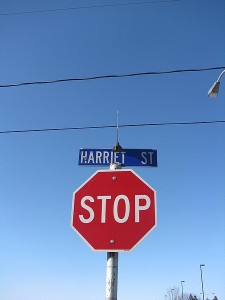 Many thanks to Matilda Magtree for sending me this wonderful photo. I will show it to Harriet tomorrow and she’ll be delighted because she is able to read every word found within it, and because it also includes her favourite word in the entire universe (which is Harriet, of course).
Many thanks to Matilda Magtree for sending me this wonderful photo. I will show it to Harriet tomorrow and she’ll be delighted because she is able to read every word found within it, and because it also includes her favourite word in the entire universe (which is Harriet, of course).





